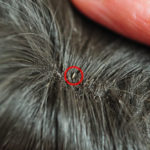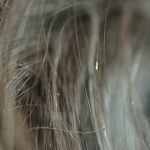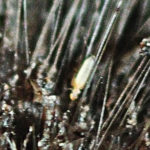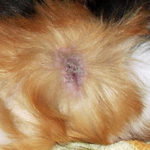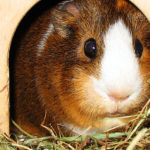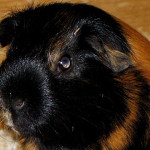Biting Lice belongs to the group of parasites which affects Guinea Pigs. General information about parasites on Guinea Pigs can be found on the linked site. You have to ensure consistency of treatment to defeat them if your Cavy runs in trouble an cause an outbreak of Biting Lice. For humans, Biting Lice are harmless, but for your pig this becomes a serious struggle if you spot the problem too late or do not help quickly. If you are much too late your Guinea Pig can die due to complete exhaustion caused by Biting Lice.
Biting Lice will be transmitted by body contact from one Guinea Pig to another. If one of them gets Biting Lice you have to treat the complete group. Separation does not really help because you will spot the problem mostly if it is already too late for that.This is Biting Lice
Biting Lice belongs to the group of ectoparasites. This means that the parasites infect the fur and skin of an host like your Guinea Pigs. Biting Lice – as the name mentioned – bites the pig and penetrate into the skin to feed themselves. Therefore it can transmit other diseases like tapeworms and weakens the Cavy. A weak immune system is the reason for secondary diseases and your pet runs in serious problems.
There are about 18 different particular classes of Biting Lice known but not all live in all regions around the world. The treatment does not vary so it does not matter what kind of Biting Lice your Cavy is infected with.
Frequent occurrence of an outbreak is at the end of the winter / begin of spring but Guinea Pigs can be infected through the year if it is not in the best condition.
Images of Biting Lice like you can spot it on your cavies fur:
- Another image how you should identify and see a Biting Lice at the hairline in the fur.
- A single biting lice spotted on the hair at a Guinea Pig. We walks and its size is about 1 – 1.5mm
- This macro image shows a detailled Guinea Pig Biting Lice on the cavies fur at hairline.
What causes Biting Lice?
- Pre-existing conditions
If your pig is already sick Biting Lice may have an easy ride to increase its population. Try to keep you pigs healthy. - Stress
Stressors like limited space or rank fights can affect the immune system which opens the door for parasites like Biting Lice. - Bathing
You destroy much of its natural coating and microsystem for weeks if you think you might have to bathe your cavies. In fact: You have not! It is a serious stressor and causes an outbreak of Biting Lice. Read our article about Bathing Guinea Pigs for more information about that.
And where did Biting Lice come from? This is a really good question but there is not really a clear answer about that. It is assumed that they come along most likely from hay, straw or litter and infest your pets that way.
Diagnose of Biting Lice
- Biting Lice are visible for human eyes and can be easily spotted with a magnifier.
- Get some transparent tape and fix the parasites on the glue. Your veterinarian can determine the parasites with a microscope.
Disease symptoms of Biting lice
An outbreak progressed serveral steps.
- Biting lice as mentioned above bites the Guinea Pig which causes strong itching.
- Your pig starts squeaking and twitching.
- Loss of hair.
- Apathy if a really big outbreak has occured.
- Health an condition become weak.
Treatment of Biting Lice
Biting Lice can be treated very good!
At mild or moderate infestation you can use a organic spot-on product like Amerta quite good to treat your pig with care. Amerta will clogge the Lice` respiratory system and they will die. You do your best if you repeat the treatment each day till no new Biting Lice can be spotted. After a treatment the fur of your Guinea Pig become greasy. This is normal and no reason to bathe them. It will be done automatically. Remember to spray the envirionment also!
A hard infestion of Biting Lice should always be examined by a veterinarian!

